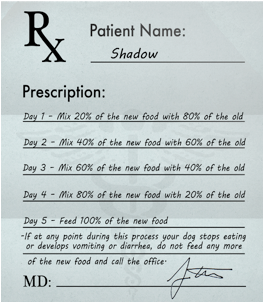How to Switch Dog Food
Owners can find themselves in the position of having to switch dog foods for any number of reasons. Maybe your dog has been diagnosed with a dietary responsive disease. Perhaps it’s time to switch from puppy to adult food or from adult to mature food. Or maybe you’ve simply decided that your dog’s current diet isn’t the best choice for him anymore.
Whatever the reason for the change, owners commonly ask how to switch dog food while ensuring their dog will be receptive to it. The pat answer that you’ll often hear is "gradually," but this can mean different things to different people and it may not always be the ideal way to go. So, here’s my take on the best way to change dog food under a couple of different scenarios.
Why does it matter what method I use to change my dog’s diet? Well, sometimes it doesn’t. If you have a dog with an iron stomach, you can probably get away with any method you want. After all, in comparison to some of the things these dogs eat with no ill-effects, moving from Brand A to Brand B, or a switch from a beef-based to a chicken-based diet is relatively benign.
But for the rest of you out there who are either uncertain of the nature of your dog’s gastrointestinal tract or, like me, know you have a dog that’s just looking for an excuse to develop diarrhea (or lose its appetite, vomit, etc.), gradually is usually the way to go. The directions I hand out to my clients under the circumstances I just outlined read as such:
- Day 1 – Mix 20% of the new food with 80% of the old.
- Day 2 – Mix 40% of the new food with 60% of the old.
- Day 3 – Mix 60% of the new food with 40% of the old.
- Day 4 – Mix 80% of the new food with 20% of the old.
- Day 5 – Feed 100% of the new food.
- *If at any point during this process your dog stops eating or develops vomiting or diarrhea, do not feed any more of the new food and call the office.
There are times, however, when I do recommend the cold turkey approach. In cases of gastroenteritis, heart failure, kidney disease, some type of bladder stones, canine cognitive dysfunction or food allergies, I will use a prescription diet as I would a medicine because I want the benefits to kick in ASAP. If we have reason to be particularly concerned about a dog developing gastrointestinal distress, I might recommend a slower approach or add a probiotic or other medication into the mix, but I’ve rarely had to do so.
On the other hand, if your dog is a picky eater or if you are dealing with a chronic condition like obesity or osteoarthritis, where delaying full implementation of the new diet by a couple of days won’t do any harm, mixing the old and new foods together for a few days can maximize the chances that your dog will be receptive to the change.
As you can see, there is no one-size-fits-all method for changing from one dog food to another. Perhaps the best rule of thumb is to use the gradual approach unless your veterinarian recommends otherwise.
